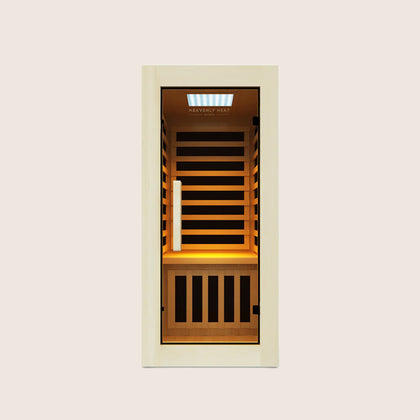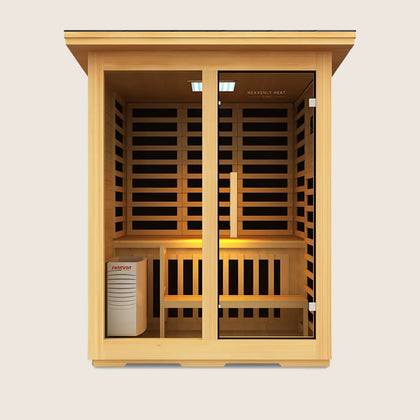Infrared Saunas With Premium Canadian Hemlock & Cedar Wood [Luxury Picks]
![Infrared Saunas With Premium Canadian Hemlock & Cedar Wood [Luxury Picks]](http://heavenlyheatsaunas.com/cdn/shop/articles/img-1762488476769_e64fb4c8-df19-4c7e-9dcd-4076c66d0b82.jpg?v=1762495335&width=3840)
Step into pure relaxation with our top picks for infrared saunas made from premium Canadian Hemlock and Cedar wood.
These saunas bring natural beauty, soothing aroma, and lasting quality into your home.
Discover why these luxury woods stand out, how they transform your sauna time, and what makes them the best choice for comfort and style.
Key Takeaways
Choose Premium Woods: Canadian Hemlock and Cedar offer durability, low toxins, and soothing aromas.
Consider Heat and Durability: Cedar and hemlock retain heat well and resist warping for long-lasting comfort.
Mind Aroma and Appearance: Wood scent and grain enhance relaxation and the overall sauna experience.
Prioritize Safety: Avoid treated or high-resin woods to prevent harmful fumes and irritation.
Maintain Regularly: Oiling and proper ventilation extend the life of your sauna wood.

Infrared Saunas With Premium Canadian Hemlock & Cedar Wood [Luxury Picks]
I recently added the 2 Person Red Light Therapy Infrared Sauna to my home, and it’s been a game-changer.
From the moment I set it up, super easy with no electrician needed, it’s been pure relaxation.
The combination of far infrared heat and red light therapy feels incredible, helping me unwind after long days and even improving my sleep.
I love that it’s crafted from non-toxic Canadian Hemlock and cedar wood with ultra-low EMF, so I feel safe while using it.
Honestly, it’s like having a mini spa at home, perfect for detox, stress relief, and just feeling healthier overall.
Other Popular Sauna Woods: Eucalyptus, Basswood, Common Alder, Aspen, Pine, Spruce
Eucalyptus
Eucalyptus is a popular sauna wood because it is durable and resists warping in high heat. It gives off a fresh, pleasant aroma that can help ease breathing and enhance relaxation.
This wood stays strong over time, making it reliable for sauna use. Cleaning eucalyptus is simple, just wipe it down regularly and oil it occasionally.
Eucalyptus also comes from sustainable sources, making it an eco-friendly choice for those who want a long-lasting, natural sauna experience.
Basswood
Basswood is a top choice for sauna construction, especially in North America and Europe, due to its hypoallergenic, odor-free qualities.
Unlike pine or cedar, it has virtually no resin, so it won’t drip sap or produce strong smells when heated. This makes it ideal for people with allergies or respiratory concerns.
Basswood also resists cracking and doesn't off-gas at high temperatures, which is particularly beneficial for infrared saunas.
While its heat resistance is good, it doesn't retain heat as well as denser woods like cedar, but it still provides decent insulation.
It’s low in toxins and allergens, with scientific data supporting its safety as a hypoallergenic wood when used in finished products.
However, it does require more maintenance compared to cedar, needing regular cleaning and ventilation to prevent moisture-related issues.
In short, Basswood’s neutral odor, low resin content, and gentle heat make it a great choice for those with sensitivities.
Common Alder
Common Alder is a popular choice for sauna construction, especially when thermally modified.
This wood stands out for its moisture resistance and ability to stay cool to the touch, making it comfortable for sauna users.
Its natural resistance to decay and warping is further enhanced through thermal treatment, increasing its lifespan compared to untreated woods like Aspen or Basswood.
Alder’s reddish-brown color adds warmth and a pleasant texture to sauna interiors. Grown mainly in Europe, southwestern Asia, and northern Africa, it's available at a moderate cost, positioned between budget-friendly options like Pine and higher-end choices like Western Red Cedar.
While untreated Alder is less durable and may require more maintenance, the thermally treated version is ideal for high-traffic saunas due to its enhanced stability.
Overall, Common Alder offers a solid combination of affordability, durability, and aesthetics for sauna construction.
Aspen
Aspen wood is a top choice for saunas due to its unique combination of durability, heat resistance, and aesthetic appeal.
It has low thermal conductivity, meaning it absorbs and distributes heat evenly, preventing uncomfortable hot spots.
Unlike many other woods, Aspen has a low resin content, making it less likely to irritate sensitive skin and providing a clean, soothing sauna experience.
With proper treatment, like thermal modification, Aspen can last 15-25 years, even with exposure to moisture and high humidity.
Thermally modified Aspen is more dimensionally stable, resistant to decay, and requires less maintenance compared to untreated wood.
Additionally, Aspen is a sustainable option, with certifications like FSC and PEFC ensuring that it's sourced responsibly.
Its light color and gentle scent also contribute to the overall tranquility and beauty of the sauna environment.
Whether you're looking for functionality, durability, or eco-friendliness, Aspen wood offers it all.
Pine
Pine is one of the most widely used woods for saunas due to its affordability and availability, making it a popular choice for budget-conscious builders.
However, its high resin content can cause it to get uncomfortably hot, release sticky sap, and even lead to burns.
In terms of thermal conductivity, pine heats up quickly, but it doesn't retain heat well, making it less ideal for stable sauna temperatures compared to woods like aspen.
While untreated pine tends to warp and crack in high-humidity environments, thermally modified pine offers improved durability, moisture resistance, and stability, making it a better choice for sauna interiors.
Despite these improvements, pine's lower overall durability and risk of splintering mean it often requires more maintenance over time than premium woods like cedar.
For a comfortable and long-lasting sauna experience, higher-quality woods may be a better investment.
Nonetheless, pine remains a solid option for those seeking a budget-friendly, traditional sauna.
Spruce
Spruce is a popular choice for sauna construction because it is durable and has a smooth, light finish.
Compared to pine, it contains less resin and feels more comfortable for benches. Spruce handles high heat well and resists moisture and humidity, ensuring long-lasting performance.
When heated, it gives off a mild, fresh scent that enhances the sauna experience. Its combination of strength, comfort, and subtle aroma makes spruce an excellent choice for any sauna interior.
Factors to Consider When Choosing Sauna Wood
Wood Type and Species
When choosing wood for your sauna, wood type and species are crucial factors to consider.
The most commonly used sauna woods are Nordic spruce, which makes up about 90% of global sauna construction, followed by Western Red Cedar and Western Hemlock.
These woods are popular for their durability and resistance to moisture and heat. For example, Cedar excels in high-heat environments due to its natural oils, offering excellent resistance to decay, while Hemlock is stable and absorbs moisture efficiently, though it requires proper treatment.
Nordic Spruce is also a great choice for moisture handling but may leak sap at high temperatures.
Red Cedar is especially valued for its pleasant aroma and therapeutic benefits, making it a favorite for saunas in North America.
These woods not only ensure durability but also create a soothing, aromatic experience for sauna users, backed by both industry practices and scientific findings on their low toxicity and pleasant scents.
Heat Resistance and Durability
When choosing sauna wood, heat resistance and durability are key factors to consider.
Different woods react to heat in varying ways. Cedar and hemlock, for instance, retain heat well, maintaining stable temperatures for longer, while pine and spruce heat up quickly but lose warmth just as fast, making them ideal for short sessions.
As softwoods, cedar and hemlock are better at insulating, whereas hardwoods like aspen conduct heat more rapidly, warming the air faster.
Over time, long-term heat exposure can impact the wood’s appearance and structure. Studies from Pigment & Resin Technology reveal that rougher wood surfaces degrade faster than planed ones.
Heat treatment can improve wood’s stability and moisture resistance, yet it can cause discoloration or cracking, particularly without proper coatings.
On average, sauna woods like cedar can last 15–25 years, while thermally modified woods like Thermowood can endure for 25–35 years.
Regular maintenance and ventilation are crucial for prolonging the lifespan and keeping your sauna comfortable.
Aroma and Scent
Cedar and Canadian hemlock release a pleasant aroma that intensifies when heated. Some woods have a subtle scent, while others may be strong or unpleasant.
High-quality wood’s fragrance usually mellows over time, enhancing relaxation and creating a spa-like sauna experience.
Appearance and Grain
The grain pattern of sauna wood defines its appearance. Straight grain creates a clean, modern look, while wavy grain adds natural elegance.
Knots provide rustic charm but can disrupt uniformity. Color may change over time, cedar deepens to amber, hemlock stays light.
Smooth wood looks polished, while textured wood emphasizes its natural origin. Choosing an appealing grain enhances the sauna’s craftsmanship and style.
Safety and Toxicity
When choosing sauna wood, safety is essential. Some woods release toxic fumes when heated, so always use chemical-free options.
Aromatic woods can cause respiratory irritation or allergic reactions, so choose mild, natural types.
Avoid treated, painted, or stained wood, as heat can release harmful chemicals. High temperatures can also affect wood stability, so select species that resist warping.
For long-term use, Canadian Hemlock and Cedar are ideal, they handle heat well, have low resin, and provide a safe, comfortable sauna environment.
Maintenance and Longevity
Sauna wood must withstand heat and moisture. Cedar resists humidity well, while hemlock needs more care.
Treating wood with oils or sealants every six months protects it. Watch for dark spots, splintering, or cracks as signs of deterioration. Choosing heat-tolerant species and proper maintenance prolongs wood life.
Cost and Availability
When choosing sauna wood, cost and availability matter. Cedar usually costs more than hemlock or spruce because of its durability and aroma.
Locally sourced wood is cheaper than imported options, which can be harder to find.
Hemlock and spruce are the most common in local markets, keeping prices lower. High availability generally reduces cost, but market trends, seasonal demand, and supply shortages can still affect prices.
Considering both cost and availability helps you pick the right wood for your sauna without overspending or facing delays.






























